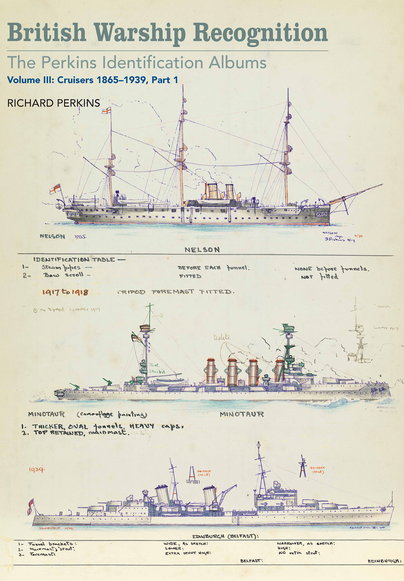
British Warship Recognition: The Perkins Identification Albums. Volume III: Cruisers 1865-1939, Part 1. By Richard Perkins. Seaforth publishing, Barnsley, 2017
Reviewed by David Hobbs
THE third volume of the Perkins identification albums follows the same large, fully-coloured format as the first two. It meets the same high and exacting standards but since there were so many cruisers in the navies of the British Empire and Commonwealth, only half of them are covered with the remainder to follow in volume IV.
It contains 191 pages of data in which there are 292 drawings of ships and the detail drawings of funnels, masts and rigging that have become such features of this series. The bulk of the ships fall into the armoured cruiser category of the late nineteenth and early twentieth centuries, among them the RN armoured cruiser AUSTRALIA of 1886 which was scrapped in 1905. HM Australian ships SYDNEY, HOBART, PERTH, SHROPSHIRE, AUSTRALIA and CANBERRA appear among their RN contemporaries in the latter half of the book.
This quality of reproduction does not come cheaply and the UK recommended purchase price for this book is £60.00 but it contains beautifully coloured warship sketches and a remarkable amount of detail that simply cannot be found anywhere else but in the National Maritime Museum’s collection at the Brass Foundry in Woolwich. It will enable readers to identify ships from old photographs together with, in the majority of cases, sufficient detail to tell when and perhaps even where the ship was serving when the image was taken. As in the previous two volumes, the data boxes that accompany each class drawings give salient facts that are easy to assimilate. For instance the data on page 160 shows that HMAS CANBERRA was fitted with a crane in 1928 shortly after completion and an aircraft catapult in 1936. In 1939 she was reconstructed to the standard shown in the sketch on that page and the table on page 161 shows that she was the flagship of the Rear Admiral Australian Squadron from 1932 onwards.
As in the earlier volumes, Perkins continued to illustrate ships’ appearances after they were withdrawn from front-line service and rebuilt for use as training ships or hulks. HMS FISGARD on page 97 is a typical example with a name that subsequently became familiar to many generations of artificer apprentices. If the cruisers, or even the hulked training ships, of this period are a source of interest for you, this book contains a fascinating amount of material which was gathered by the author as his life’s work before wartime security restrictions brought it to an end in 1939.
It can fairly be described as unique and, if this is your area of interest, this book will fall into the essential category and I thoroughly recommend it.



